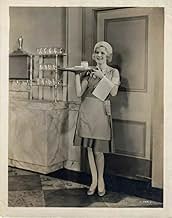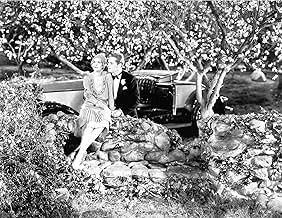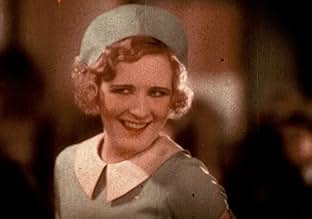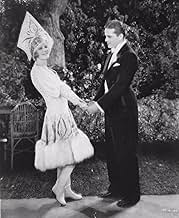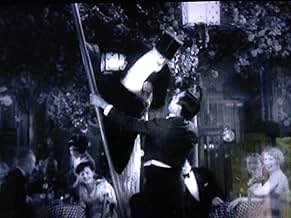Füge eine Handlung in deiner Sprache hinzuSally was an orphan who got her name from the telephone exchange where she was abandoned as a baby. In the orphanage, she discovered the joy of dancing. Working as a waitress, she goes from ... Alles lesenSally was an orphan who got her name from the telephone exchange where she was abandoned as a baby. In the orphanage, she discovered the joy of dancing. Working as a waitress, she goes from job to job until she finds a job that also allows her to dance. At the restaurant, she mee... Alles lesenSally was an orphan who got her name from the telephone exchange where she was abandoned as a baby. In the orphanage, she discovered the joy of dancing. Working as a waitress, she goes from job to job until she finds a job that also allows her to dance. At the restaurant, she meets Blair and they fall for each other, but Blair is engaged to Marcia. Sally is hired to i... Alles lesen
- Für 1 Oscar nominiert
- 1 Gewinn & 1 Nominierung insgesamt
- Undetermined Role
- (Nicht genannt)
- Cafe Customer
- (Nicht genannt)
- Chorus Girl
- (Nicht genannt)
- Party Guest
- (Nicht genannt)
- Cafe Customer
- (Nicht genannt)
- Girls in dance number
- (Nicht genannt)
Empfohlene Bewertungen
** 1/2 (out of 4)
Better than average Musical from Warner about a down on her luck waitress (Marilyn Miller) who dreams of making it big as a dancer and finally gets a shot thanks to a man (Alexander Gray) who turns out to also be a major love interest. This story was a big hit on Broadway and it was even made into a film in 1925 but it seems it has now been forgotten as has its star Miller. Miller was apparently one of the biggest names on Broadway and she was making her film debut here but she's end up dead a short seven-years later due to alcohol and health problems. Many consider this her shining moments and she certainly leaves an impression even if it wasn't the one I was expecting. The actual story here will probably strike many as being unoriginal but one must remember that this movie came before many future films that would follow the same Cinderella-type structure. The one problem I had with the structure is that it seemed like Miller became famous way too quickly but this is just a minor thing. I went into this thing expecting great music numbers and poor "acting" but I actually got the opposite. I thought the entire cast delivered fine performances and they actually made the story flow a lot better than it would have with other actors. Gray has a very good voice but he also handles the role quite well and makes a memorable character. Joe E. Brown is here for comic relief and nearly steals the film in a couple classic scenes. One has an old man paying him some extra money to get into the club so Brown makes him climb a ladder to reach a tree house. Another laugh riot follows when Brown makes life Hell on a guy who comes to the club to impress a girl but doesn't have enough cash to pay for what she wants. I think most people are going to be checking this film out to get a glimpse of Miller and she's certainly very easy on the eyes. Her acting range really impressed me as she came off quite natural and I thought she was very believable as the girl dreaming for something big. I thought her dancing scenes were terrific and her comic timing was able to match Brown's and the two appear to be having fun together. The strange thing is that I wasn't overly impressed with her voice, which is something most other reviewers really praised. It wasn't horrible but I just didn't really get into it. The film was originally released in 2-strip Technicolor but sadly that version has gone missing so we're left with a B&W print that features the only remaining color footage, which lasts around three-minutes. It's a real shame that the color stuff is missing but the footage that does survive is in pretty rough shape but then again the B&W print is in tough shape.
Supporting her is a very young Joe E Brown (best known as Captain Andy in the third film version of Show Boat) who is a lot of fun, and Alexander Gray, who like many other leading men of the early talkies is a bit of a stuffed shirt. You'll also spot the Keystone Kops' Ford Sterling as 'Pops'.
'Sally' is a hugely enjoyable early talkie. The colour sequence is lovely and bright - it is a pity that we lose the impact from the rest of the film. The songs are good and Miss Miller is a treat to watch. Try to catch this when it next airs on TCM.
The story is adapted from the Ziegfeld show of the same name. It is about Sally Green (Marilyn Miller), an orphaned girl who waitresses and cooks in a diner for a living, but dreams of being a professional dancer. In fact, the very first shots of the film are of Miller's feet as she dances while she works. She also has an admirer (Alexander Grey) who stares at her from outside the café where she works, causing her to get so enthralled in his gaze one day that she inadvertently makes the world's largest pancake. Sally is basically a Cinderella story, and a charming one at that. There is no evil stepmother in this fairy tale, however, so you can just sit back and enjoy this light romantic comedy and its beautiful musical numbers. The romance is provided by Alexander Gray and Marilyn Miller, and the comedy is mainly provided by Joe E. Brown. Brown plays a prince made penniless by a revolution in his country of origin who now works at the restaurant with Sally and is also her good friend. One of the most delightful scenes in the film is where the two dance to "Look for the Silver Lining" with Miller doing her more formal interpretation alongside Brown's eccentric dancing.
Someone else compared Marilyn Miller to Irene Dunne, and there is one scene where that is particularly true. An agent has a famous dancer client who has run out on him the night before she is to perform at a big society party. Sally helps him out by impersonating that dancer complete with a ridiculous accent and an outlandish headdress. This comedy bit very much reminded me of something Irene Dunne would do.
The film was originally shot in two-strip Technicolor, but only one color scene still exists. That one scene is Miller dancing to "Wild Rose" at a society party, and the colors there are truly splendid. As soon as the Technicolor kicks in, for some reason, so does a higher quality level on the sound. Highly recommended for the fans of the early talkie musicals.
Produced by Florenz Ziegfeld Jr., the Cinderella-like "Sally" (1920-1922) was a huge Broadway success for Miller. With this show, plus her high-profile 1922 marriage to Hollywood royalty (Mary's brother Jack Pickford), Miller was a big star before she ever made a motion picture. Reportedly, the Pickfords did not get Miller in the movies earlier because they felt her skills were not flattered by the silent movie medium; this is evident. "Sally" (also a re-make of the hit 1925 "silent" version starring Colleen Moore) was a top-line production, in full Technicolor. Gray sounds great as Miller's leading man and Brown is a best supporting actor - even without kissing T. Roy Barnes...
Unless more is found, only a rough black-and-white print of "Sally" survives. The only color portion available has most of Miller's "Wild Rose" dance and a small portion of Mr. Brown's subsequent scene. These brief color minutes indicate the whole work was visually quite appealing. However, the staging and plot are not spectacular. Miller's dancing is a highlight. Probably, she would have been a bigger musical movie star in the 1940s. Her great comic "pas de deux" with Brown makes one long for other Miller dance team-ups. Jerome Kern's music is most memorable. "Look for the Silver Lining" became a #1 million-selling hit song in 1921, and a standard thereafter.
****** Sally (12/23/29) John Francis Dillon ~ Marilyn Miller, Alexander Gray, Joe E. Brown, T. Roy Barnes
A few years ago, Turner Entertainment released the remains of what's left of a primitive early talkie called SALLY. SALLY was a legendary stage show first produced by Ziegfeld in 1919, representing Miss Miller's greatest triumphs. In 1929, she was given the opportunity to preserve her performance in this oversized adaptation.
The entire film was shot and released in 2-color Technicolor, and this process apparently had the by-product of enhancing the range of the sound.
The film is undeniably dated. It lacks rhythm that later films would quickly master. What is thrilling and fascinating is to watch this great star, Marilyn Miller, in action. Her greatest asset was her dancing, though even that wobbly voice has its charms.
The film is in woeful need of restoration. That said, it is pretty much all there. Provided the viewer is able to make the leap of faith in understanding that it a technological dinosaur, you can settle in and luxuriate in witnessing something like an authentic classic Ziegfeld show.
Wusstest du schon
- WissenswertesOriginally presented in 100% two-color Technicolor, at present the complete film survives only in black and white, with a singular musical number, "Wild Rose," in color.
- Zitate
Otis Hooper: [to 'Connie', the waiter] I have 10 bucks - and only 10 bucks.
[opens the menu]
Otis Hooper: What would you suggest?
'Connie': Another restaurant.
- VerbindungenFeatured in Broadway: The American Musical (2004)
- SoundtracksSally
(1920) (uncredited)
Music by Jerome Kern
Lyrics by Clifford Grey
Played during the opening credits and often in the score
Sung by Alexander Gray and Chorus
Danced by Marilyn Miller and Joe E. Brown
Danced by Miller and Albertina Rasch Dancers at the follies
Top-Auswahl
Details
Box Office
- Budget
- 647.000 $ (geschätzt)
- Laufzeit1 Stunde 43 Minuten
Zu dieser Seite beitragen



